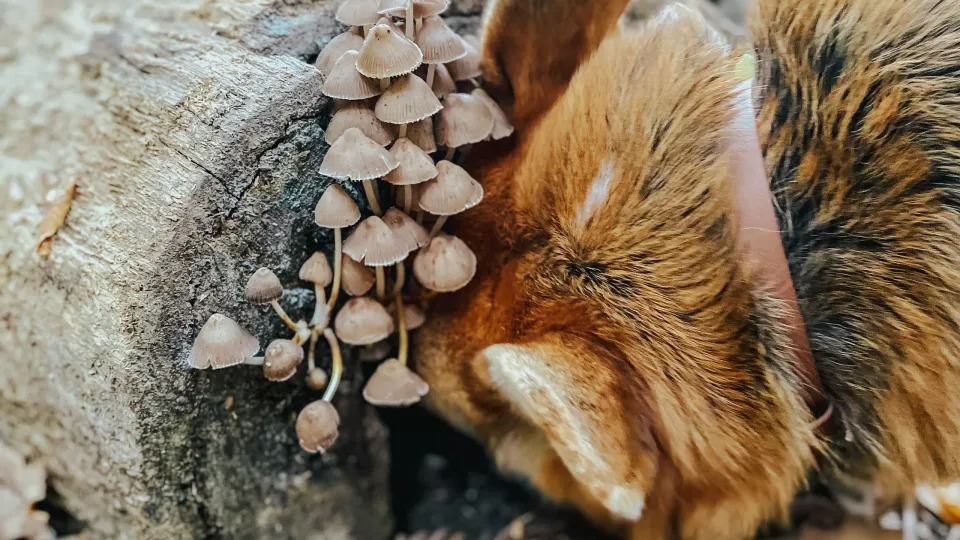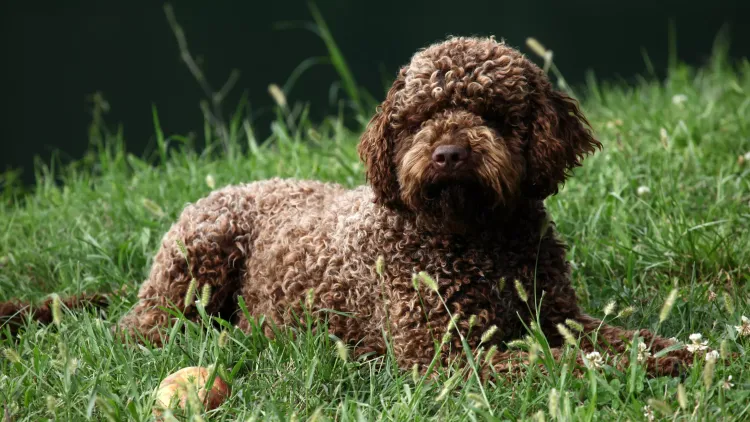Man's Best Friend in Mushrooming: Dogs That Lead the Way

Mushroom hunting, or 'foraging', has grown increasingly popular in recent years. And while human intuition and experience play an undeniably essential role in successful hunts, some dog breeds have a particular aptitude for tracking down these fungal delicacies. Let's dive into the breeds that can elevate your foraging game.
Top Dog Breeds for Mushrooming
Mushroom foraging is an age-old practice that has seen a resurgence in popularity. While human expertise remains invaluable, specific dog breeds have a natural knack for helping enthusiasts locate these hidden fungal treasures. Here's a list of the top breeds that excel in the art of mushrooming:
1. Lagotto Romagnolo:
- Background: Hailing from the Romagna sub-region of Italy, the Lagotto Romagnolo is perhaps the most iconic mushroom-hunting dog, specifically revered for its truffle-hunting prowess. Historically, before their truffle hunting days, they were used as water retrievers, giving them an innate love for water and marshy terrains, which often accompany mushroom-rich environments.
- Physical Features: Sporting a dense, curly coat, the Lagotto is uniquely equipped to deal with damp forest conditions. Their medium size (generally weighing between 24-35 pounds) allows them to maneuver through thickets and underbrush with ease, and their sturdy build ensures they can handle extended forays.
- Temperament: Beyond their physical attributes, their temperament makes them ideal for hunting mushrooms. They possess a keen intelligence, a strong work ethic, and a deep desire to please their owners. They're also known to be affectionate and loyal, forming a tight bond with their human companions.
- Training: Their sharp intellect means they're responsive to training. Starting young is ideal. Introducing them to the specific scents of mushrooms you're after will help refine their searching abilities. As with most breeds, positive reinforcement is key. Rewarding them with a treat or praise when they successfully locate a mushroom can optimize their efficiency.
- Strengths: The combination of their exceptional nose, the right size for navigating varying terrains, and their innate passion for the hunt makes the Lagotto Romagnolo a premier choice for mushroom enthusiasts.
2. Belgian Malinois:
- Background: The Belgian Malinois originates from Malines, a region in Belgium, where they were primarily used as sheep herding dogs. Due to their intelligence, agility, and keen senses, they quickly gained prominence in various roles, from police and military duties to search and rescue operations.
- Physical Features: Athletic and graceful, the Belgian Malinois possesses a short, fawn-colored coat that's weather-resistant, enabling it to work in diverse conditions. They have an alert expression and square build, weighing usually between 40-80 pounds, depending on gender and specific breeding.
- Temperament: They are known for their high drive, making them incredibly eager to work and please their handlers. Their alertness, combined with an inherent protective nature, ensures they stay attentive during forays, always keen to fulfill their assigned tasks.
- Training: The Belgian Malinois is highly trainable. Their intelligence and eagerness to learn means they can quickly adapt to mushroom hunting when exposed to particular scents. Consistent training sessions, combined with their innate work ethic, can make them reliable mushroom hunters. They thrive on challenges, so creating games around mushroom foraging can further stimulate their minds and refine their searching skills.
- Strengths: Their supreme olfactory skills are their primary asset in mushroom hunting. Coupled with their high energy levels, they can cover vast terrains quickly. Their protective nature also ensures the safety of their handlers in isolated woods or forests.
3. Bloodhound:
- Background: Tracing its roots back to medieval France, the Bloodhound, or "Chien de Saint-Hubert" as it's known in its native land, has an illustrious history as a tracker. Monks at the Saint-Hubert Monastery in Belgium are credited with its early breeding. Over centuries, the Bloodhound's unparalleled scenting ability made it the go-to breed for trailing, often used in law enforcement to track criminals or missing persons.
- Physical Features: Distinctive for its droopy eyes, long ears, and wrinkled skin, the Bloodhound has a noble and somewhat melancholic appearance. Their loose, elastic skin, especially around the neck, helps trap scents, aiding in their tracking ability. Typically, they weigh between 80-110 pounds and possess a short, dense coat that can be black and tan, liver and tan, or red.
- Temperament: Gentle and affectionate, Bloodhounds are incredibly good-natured dogs. Despite their somewhat laid-back demeanor at home, when they're on a scent trail, they exhibit unparalleled focus and determination. Their single-mindedness when tracking can sometimes make them seem aloof, but they're generally very social and get along well with humans and other animals.
- Training: Given their innate tracking instinct, Bloodhounds can be introduced to mushroom hunting with relative ease. Exposing them to the specific scent of desired mushrooms and rewarding them for successful finds can quickly hone their skills. However, their determination to follow a scent can sometimes lead them to wander, so it's crucial to ensure they're trained to respond to recall commands.
- Strengths: The Bloodhound's sense of smell is among the best in the canine world. Some claim they can follow trails that are over a week old. In mushroom hunting, this means they can detect even the most faintly scented fungi buried beneath leaves or soil. Their long ears play a role too, sweeping scent particles toward their powerful nose as they move.
4. German Pointer (both Shorthaired and Wirehaired):
- Background: The German Pointer family, consisting of the Shorthaired and Wirehaired varieties, originates from Germany, where they were developed as versatile gun dogs. Their initial purpose was to locate and point game birds, but their adaptability has seen them used in various hunting roles over the years.
- Physical Features: Both versions of the German Pointer are robust and agile, built for stamina and speed. The Shorthaired variety has a short, dense coat that can range from liver to liver and white in color. In contrast, the Wirehaired sports a wiry, weather-resistant coat of liver with white, or just liver. Their keen eyes always seem to be scanning the environment, and their muscular build typically weighs between 45-70 pounds.
- Temperament: German Pointers are known for their high energy levels and intelligence. Eager to work and always alert, they form close bonds with their handlers, making them excellent companions in the field. Their inherent curiosity and drive to locate and "point" make them naturally suited to tasks like mushroom hunting.
- Training: Their training as bird dogs, where they're taught to point at the game without disturbing it, can be adapted seamlessly to mushroom foraging. By introducing them to the scent of mushrooms and using their natural pointing instinct, they can be taught to indicate the presence of fungi without touching or disturbing them. Consistent reinforcement with rewards when they successfully locate a mushroom can further enhance their foraging skills.
- Strengths: The German Pointer's natural inclination to search and point is its most significant strength in the world of mushroom hunting. Their stamina ensures they can cover vast tracts of land without tiring easily. The Wirehaired's coarse coat offers some protection against brambles and thorny underbrush, while the Shorthaired's sleek coat allows for swift movement.
5. Springer Spaniel:
- Background: The English Springer Spaniel, originating from England, was primarily bred as a gun dog to "spring" or flush out game from dense underbrush. This breed has a rich history dating back several centuries, and its name "Springer" derives from its traditional hunting role.
- Physical Features: Medium-sized with a compact body, the Springer Spaniel showcases a blend of strength and agility. They possess a glossy, water-resistant coat that can be either wavy or straight and comes in various color combinations like liver and white, or black and white. Weighing typically between 40-50 pounds, they have a keen, expressive look in their eyes that suggests alertness and curiosity.
- Temperament: Springer Spaniels are renowned for their friendly and affable nature. They are eager to please, making them very trainable and responsive to commands. Their boundless energy and zest for life mean they're always up for an adventure, making them ideal companions for outdoor activities like mushrooming.
- Training: Their natural propensity to flush out the game can be channeled effectively for mushroom hunting. By introducing them to the scent of mushrooms and using positive reinforcement techniques, they can be trained to sniff out and signal the location of fungi without disturbing the surrounding area. Their keen sense of smell and instinctual drive to search makes them adept mushroom foragers.
- Strengths: Their medium size and energetic nature mean they can navigate through dense forests or open fields with equal ease. Springer Spaniels have an innate curiosity that drives them to explore every nook and cranny, ensuring that very few mushrooms remain undetected. Their water-resistant coat also means dew or light rain won't deter them from their search.
6. Poodle (Standard, Miniature, and Toy):
- Background: The Poodle, often associated with French luxury, originally hailed from Germany where it was known as a "Pudel," derived from the German word for "puddle." Contrary to popular belief, Poodles were initially bred as water retrievers, fetching games from bodies of water.
- Physical Features: Poodles come in three sizes – Standard, Miniature, and Toy. All variants sport a distinctive curly or corded coat that's hypoallergenic, making them ideal companions for those with allergies. The Standard Poodle is the largest, often weighing between 40-70 pounds, while Miniatures range from 10-15 pounds and Toys are under 10 pounds. Their keen, alert eyes and squared build give them a dignified appearance.
- Temperament: Poodles are known for their intelligence, often ranking among the top most intelligent dog breeds. They are eager to learn, adaptable, and have a playful side, making them great companions for various activities, including mushroom foraging.
- Training: Given their high intelligence, Poodles can be trained relatively quickly. Introducing them to the scent of mushrooms and using reward-based training methods can effectively hone their mushroom-hunting skills. Their natural curiosity and desire to please their handler make them attentive and diligent during hunts.
- Strengths: The Poodle's hypoallergenic coat ensures minimal allergen release, which can be especially beneficial in environments dense with spores. Their sharp intellect means they can differentiate between scents, making them efficient in distinguishing various mushroom types. The different sizes also offer versatility; while Standard Poodles can cover larger grounds swiftly, Miniature and Toy Poodles can navigate tighter spaces with ease.
7. Dachshund:
- Background: Often affectionately called "wiener dogs" due to their elongated bodies, Dachshunds were originally bred in Germany for hunting small game, especially badgers. Their unique shape was purposefully developed to enable them to dig into badger dens, showcasing their tenacity and courage.
- Physical Features: Dachshunds come in three coat varieties: smooth, long-haired, and wire-haired. Regardless of the coat type, their most prominent feature is their long body and short legs. Typically weighing between 16-32 pounds for the standard size and under 11 pounds for the miniature, they have a curious and lively expression.
- Temperament: Despite their small size, Dachshunds are fearless and often don't realize their own stature. They are playful, sometimes stubborn, but are deeply loyal to their owners. Their inherent curiosity and hunting instincts make them natural explorers.
- Training: Leveraging their innate digging and hunting instincts, Dachshunds can be trained for mushroom foraging by introducing them to specific scents. Their small size and keen nose make them effective at locating mushrooms closer to the ground. Consistency in training, using positive reinforcement methods, will yield the best results given their occasional stubborn streak.
- Strengths: The Dachshund's low-to-the-ground physique allows them to sniff out mushrooms that might be overlooked by taller breeds. Their innate digging instincts can also come in handy if truffles, which grow underground, are the target. Their smaller size is an advantage in terrains with dense undergrowth or tight spaces.
Training Tips for Any Breed:
- Start Young: While older dogs can be trained, starting young capitalizes on a puppy's innate curiosity and eagerness to learn.
- Positive Reinforcement: Always reward your dog when they correctly identify a mushroom, ensuring they associate the scent with a treat or praise.
- Safety First: Before heading out, familiarize yourself with toxic mushroom species in your region. Train your dog to detect but not consume the mushrooms.
Conclusion
While any dog can be trained to assist with mushroom hunting, specific breeds have inherent traits that make them more adept at this unique task. With patience, practice, and passion, you and your canine companion can become a formidable foraging team. Always remember that the bond you share during these hunts is just as valuable, if not more so, than the mushrooms you might find. Happy foraging!


